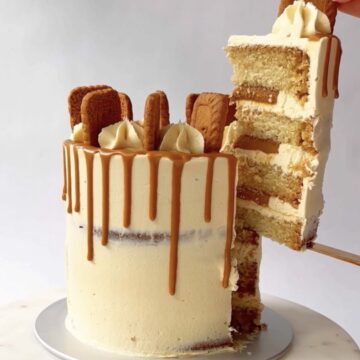
Biscoff Layered Cake
The sponge is flavoured with vanilla, the icing is flavoured with caramel and the cake is layered with decadent amounts of biscoff spread. If you are a biscoff lover, you NEED THIS. If you don’t know what biscoff is, you NEED THIS. Everyone basically needs this cake.
Ingredients
- 400 ml Milk almond, unsweetened
- 1 tablespoon Apple cider vinegar
- 300 g Sugar caster, supe-fine
- 1 ½ tablespoon Vanilla extract
- 150 ml Vegetable oil
- 350 g Flour plain, white, all-purpose
- ¾ teaspoon Baking powder
- 1 teaspoon Baking soda (bicarbonate of soda)
- ½ teaspoon Salt
- 250 g Biscoff Spread
- 6 Biscoff Biscuits
For the Buttercream
- 450 g Unsalted butter
- 550 g Icing Sugar
- 1 tablespoon Caramel extract
- ½ teaspoon Salt
Instructions
- Pre-heat your oven to 180°C/ 356°F. Prep your 6 inch baking tins with a circle of baking paper at the bottom. I use a bit of oil to make the paper stick to the tin.
- In a large bowl, combine the milk and the apple cider vinegar. Put this to the side and allow it to curdle for a couple of minutes. Then add the oil, caster sugar and vanilla extract. In another bowl, sieve the flour, baking powder, soda + salt and combine. Using a large spoon, add the dry mixture to the wet, whisking as you go.
- Pour your cake batter into 2 lined tins, evenly. Bake for 50 minutes, or until a knife comes out clean. You will need to bake this for less if you are using wider tins. For example, if you are using two 8 inch tins, only bake the cakes for 30 minutes.
- Once your cake is completely cool, slice the cake into four even layers. I use a cake leveller to do this as it is WAY easier than using a knife. To use this, set your leveller to the height you want your cake to be, and then use it to cut your sponges.
- In a standing mixer, place your butter and mix on a high speed for at least 5 minutes. This will cream your butter which will remove some of its colour and prepare it for the buttercream. Add all the remaining icing ingredients and mix on a low speed for around 30 seconds and then increase to a high speed, until combined and fluffy. Leave this mixing until it reaches your desired colour/ texture. Add 1 tablespoon of water at this point if you think the icing needs to loosen up a little bit.
- Using a cake plate, layer all of the sponges up evenly with icing. Within each icing layer, create an icing barrier around the edge and place approx 1 tablespoon Biscoff spread in the middle. Piping bags make this easier.
- Using the piping bag with icing in, spread the icing around the edge and the top of the cake. Use a cake spatula to smooth all out. If you don’t have these, you can do more of a rustic pattern with a knife. Place the cake in the fridge to cool for as long as possible (ideally at least a couple of hours).
- Place 3 tablespoon Biscoff spread into a bowl and microwave for around 20 seconds, until it is melted. Add this to a small piping bag and cut a tiny hole at the edge of the piping bag, to drip onto the cake. Carefully drip the spread onto the edge of the cake, with around a 1cm gap between each drip. Add a bit more spread to some drips, enabling a mix of long and short drips on the cake.
- Decorate the top of the cake in whatever way you want. I did icing swirls and then halved the 6 Biscoff biscuits and scattered them in between the icing swirls. ENJOY!
Tried this recipe?Let us know how it was!